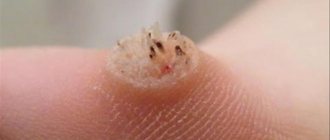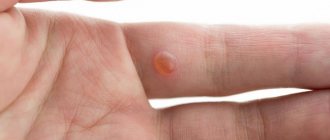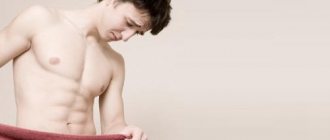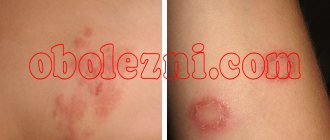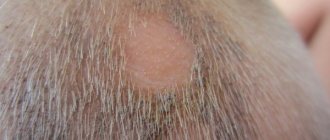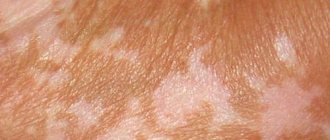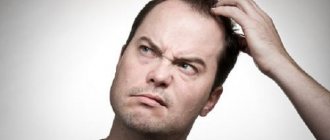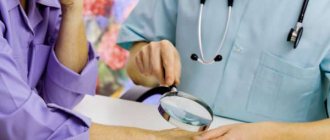The term “lichen” covers a variety of skin diseases. This is an unpleasant disease that causes physical and psychological discomfort to a person. Various formations and spots form on the skin. A person’s nervousness increases, sleep is disturbed, and if foci of infection are located in open areas of the skin, others may react inappropriately. Ringworm on the leg can be transmitted by contact. Therefore, when communicating with a patient, you need to be careful, and if the disease appears, start treatment immediately.
Ringworm - large spots or small rashes on the skin
Some types of fungi and bacteria are constantly found in the skin microflora. However, symptoms of the disease in adults more often occur after suffering stress, hormonal changes, and metabolic disorders.
What does lichen look like on a person’s legs:
- A red-pink spot resembling a ring.
- Scales and crusts on the surface of the outbreak.
- Bubbles, wet areas (not everyone).
- Burning sensation, itching.
Important! The appearance of lichen is caused not only by infection, but also by the weakness of the immune system, which is unable to cope with the problem.
The appearance of the affected area largely depends on the type of infection. In addition, the reaction of the skin and the entire body to the pathogen and its metabolic products has a significant impact. Before treating a disease, you need to accurately determine the cause.
Ringworm - large spots or small rashes on the skin
Types, causes and symptoms of lichen
Ringworm on the legs can occur through close contact with an infected person or when using their things. Pathogenic organisms remain on shoes, clothes and objects. The disease can be contracted in public places such as saunas, steam baths and solariums.
But contact with the pathogen on the skin is not enough for the development of lichen. This requires favorable conditions. The skin infection is activated by ignoring the rules of personal hygiene, weakening the body and excessive sweating.
The following factors can contribute to the appearance of lichen on the legs:
- decreased protective functions of the body;
- genetic predisposition;
- psychological trauma;
- previous chronic diseases;
- skin damage.
Each form of lichen is characterized by its own characteristics and symptoms. Before starting skin treatment, it is important to determine the nature of the pathogen and the type of disease.
Shearer
Ringworm can appear both on the scalp and on the smooth surface of the skin. The disease is caused by fungi - microsporum and trichophytum. You can become infected with lichen through contact with a sick animal or person. Pathogenic microorganisms are easily transmitted by sharing toys, clothing, and towels.
Do not start treatment for lichen without seeing a doctor! Some popular ointments can cause the disease to spread throughout the body.
On the legs, lichen is localized on the calves, feet, thighs and causes discomfort to the patient. At the initial stage of the disease, round pink spots form. They have smooth edges, scales and a whitish tint in the center. Fungal formations do not merge and do not itch. In the chronic form of lichen, the affected area increases, and the lesions acquire faint outlines.
Pityriasis
This type of lichen is also called solar or multi-colored. This is a chronic fungal infection that affects the top layer of skin. Ringworm appears in spring and summer, when the sun is most active. The disease is caused by yeast-like fungi.
Avoid direct sunlight during an exacerbation of pityriasis versicolor.
Tinea versicolor most often develops on the feet and ankles, but can spread to the legs and thighs. The formations are characterized by clear edges and a brown or dark red color. The lesions are flaky and itchy. The spots do not darken in the sun, so they stand out against tanned skin.
Pink
This is a chronic disease of infectious-allergic origin. Pityriasis rosea (or Zhiber's pityriasis) appears in people with weakened immune systems. The disease is not contagious, so the patient does not pose a danger to others.
Do not scratch spots on the skin even if it is severely itchy! Damage to the skin can lead to the addition of a purulent infection.
First, a light pink maternal plaque with a yellowish center appears on the skin of the legs. The formation is oval in shape, with a diameter of 2 to 10 cm. The skin peels and itches. After the mother's spot appears, the lichen spreads throughout the entire leg. Most often, the spots are localized on the knees. You should not scratch them, as this can cause infection and cause suppuration.
Red flat
Lichen planus, or Wilson's disease, is a rare chronic disease. The disease is caused by the production of antibodies that absorb the skin's own cells. Therefore, this form of lichen is classified as autoimmune. Infection is possible through close contact with a sick person.
Rashes with lichen planus are often multiple and located in groups, forming garlands, rings or lines on the skin.
The disease occurs with the appearance of flat plaques on the legs, which have a crimson or pinkish-red color. They are characterized by their small size (2-3 mm), a barely noticeable depression in the center and a waxy sheen. After some time, the formations begin to merge with each other. The skin itches a lot.
Typically, lichen affects the popliteal fossa, ankles and inner thighs. On the nail plates, the disease manifests itself as cracks and lumpiness.
girdling
Shingles, or herpes zoster, is caused by the chickenpox virus. It appears extremely rarely on the legs. The disease manifests itself with a sharp decrease in immunity. Shingles can only be transmitted to people who have not had chickenpox. Infection occurs by contact or airborne droplets.
Treatment should begin when the first signs appear (burning, discomfort on the skin of the legs, redness, thickening of the skin, soreness). The listed sensations appear in places of future rashes.
Before you begin treating the disease, you need to understand what lichen looks like in humans. Herpetic rash is localized in the toes and on the inner thighs. First, the affected area turns red and begins to itch, causing severe pain. Then bubbles with a cloudy liquid form. Soon the formations burst, and in their place a yellowish crust remains. The disease is accompanied by an increase in body temperature and deterioration in health.
Remedies for ringworm
Areas of redness and peeling on the legs can be lubricated with external agents with antifungal components. They come in different forms, from which it is easy to choose the most suitable means for treating lichen on the legs.
You can treat lichen in the thighs, legs, feet with ointments or gels: Ketoconazole, Terbinafine, Clotrimazole. A spray with the same active ingredients is convenient to use for quickly treating a large lesion. The advantage of ointments is a gradual penetration into the lesion where the fungal cells are located, a longer effect on the pathogen (compared to cream and lotion).
Important! The duration of therapy with antifungal drugs depends on the size of the lichen spots. In advanced cases, ointments should be used for 1–1.5 months.
Antifungal ointments:
- Clotrimazole is a topical treatment for ringworm and sun fungus.
- The Nizoral line of products with ketoconazole are drugs for the treatment of ringworm and sun fungus.
- Terbinafine, Fungoterbin, Lamisil - creams with terbinafine.
- Miconazole and Micozon - cream and ointment against fungus and bacteria.
- Antibiotic Nystatin for all types of fungal infections.
Terbinafine as part of external agents has a fungicidal effect - it kills the pathogens of ringworm, sun fungus, and skin candidiasis. It is recommended to apply a cream with this active ingredient to spots 1 or 2 times a day. Terbinafine ointment or cream can be used from 12 years of age. The age limit for treatment with the solution is 15 years, with the spray - 18 years.
How to treat
Faced with such an unpleasant problem, it is important for a person to learn how to get rid of lichen on the legs. After determining the nature of the pathogenic pathogen, you can begin to fight the disease. Each type of lichen requires its own treatment regimen.
Fungal lichens
Treatment of ringworm and pityriasis versicolor begins with the use of local antifungal agents. They are available in the form of gels, sprays, ointments, lotions and tinctures. The most effective antifungal ointments: Miconazole, Terbinafine, Ketoconazole, Exoderil, Nizoral. The product is applied to the affected areas of the legs, carefully distributed and rubbed in with your fingers. Depending on the size of the spots, the course of treatment ranges from 2 to 4 weeks.
To disinfect foci of inflammation, salicylic alcohol or iodine is used. In advanced cases, external remedies in the fight against lichen on the legs may be ineffective. In this case, complex treatment is started and systemic antibiotics with antifungal action are used. Griseofulvin is usually prescribed, which effectively neutralizes skin pathogens. It is taken daily for 15-25 days.
You should review your diet, eliminate food allergens and start taking vitamins to strengthen the body's immune system.
Before treating lichen on the leg, you should consult your doctor. After completion of therapy, carry out control tests.
Viral rash
For shingles on the legs, it is recommended to lubricate the lesions with antiviral drugs. The most effective is Acyclovir, which is available in the form of ointments or tablets. Analogues of the drug are Famciclovir and Penciclovir. Medicines suppress the activity of the virus, destroy its shell and prevent the spread of lichen. Interferon and Cycloferon are prescribed to stimulate the immune system.
To prevent self-infection, rash sites are treated with brilliant green or a weak solution of potassium permanganate. If lichen is accompanied by pain, the doctor prescribes analgesics. For this, Paracetamol, Analgin or Ibuprofen are used.
If you have shingles, you should not take Aspirin as an analgesic or antipyretic.
Complete treatment of leg lichen at home is only possible with a balanced diet and immune support. Patients are given recommendations on diet and prescribed vitamin and mineral complexes. They help strengthen the immune system and calm the nervous system.
Ringworm of unknown origin
Under favorable conditions, pityriasis rosea can go away on its own after 15-50 days. Patients are advised to reduce the number of water procedures and adhere to a hypoallergenic diet. Anti-inflammatory and antibacterial ointments are applied to the affected areas of the legs: Salicylic, Sulfuric, Sinaflan, Zinc.
To eliminate itching, take antihistamines. Suprastin, Diazolin, Tavegil are suitable. In advanced cases, combined hormonal ointments are used, for example, Lokoid. They are used for no more than a week.
When treating lichen planus, the drug Medazepam is prescribed, which relieves tension and calms the nervous system. In case of complications of the disease (a bacterial infection), the antibiotic Tetracycline is taken, but strictly according to the regimen prescribed by the doctor. If you treat lichen planus with this drug for a long time, the functioning of the liver and digestive system may be disrupted.
Sun fungus or pityriasis versicolor
Yeast-like fungi cause skin diseases in humans. Many red-brown spots appear on the body. In adults, the chest and back are most often affected, in children the legs and arms. If a person sunbathes, the spots do not darken, so they appear light against the background of darkened skin.
Treatment consists of external use of antifungal drugs with ketoconazole and bifonazole, drugs under the general name Nizoral. The lotion or spray is applied to the affected skin, distributed with fingertips and gently rubbed.
External treatment of pityriasis versicolor at home will not cause trouble if the lesion is small. The affected area should be wiped with salicylic alcohol once a day, then Miconazole or Exoderil cream should be applied. If the infectious disease becomes chronic, long-term treatment will be required.
The first signs of deprivation in humans
Photos of lichen are frightening, but the patient himself may not immediately notice the presence of unpleasant symptoms in his own body. After the rash spreads, severe itching predominates, and the skin takes on an unusual, clearly unhealthy appearance. The first signs of progressive lichen may be:
- local hyperemia of the skin;
- dry skin prone to peeling;
- swelling of the upper layer of the epidermis;
- association of individual foci of pathology;
- increased patient nervousness, poor sleep.
Pityriasis rosea
The chronic disease is of infectious-allergic origin. First, one large maternal plaque appears on the waist or abdomen. The color of the spot is pink, with a red flaky border. A week later, the formation of daughter plaques begins on the thighs, chest, and arms. The dimensions of the mother spot are 5 cm, the daughter spots are 2 cm. The skin in the center of the pityriasis rosea plaques turns yellow and is covered with many cracks and scales.
Important! Without treatment, the spots disappear on their own after 2 weeks or after 1–3 months.
After healing, the pink color in the area of the spots remains for some time, then disappears. The formation of lichen and recovery repeats throughout the patient’s life. The skin reacts to strong allergens in foods and dietary disorders. It has been noticed that the spots become more numerous after water treatments, so during an exacerbation of the disease you need to reduce bathing.
Treatment of pityriasis rosea consists of following a diet, external use of a moisturizing lotion, and antibacterial ointment. Antihistamines are taken internally to relieve itching: Fenistil, Parlazin, Cetrin, Zodak.
In difficult cases, you can apply hormonal and combined ointments: Hydrocortisone, Lokoid, Triderm, Belosalik. It is recommended to use such products in short courses - within 5-7 days. If relapses become more frequent, the patient is referred for phototherapy.
Complications and prevention
It is not the disease itself that needs to be feared, but its consequences.
Preventive actions:
- Maintaining body hygiene.
- Use only your own bathroom accessories.
- Be careful when in contact with possible carriers of the disease (animals).
- Timely treatment of chronic diseases.
- Vitamin therapy.
- Healthy lifestyle.
If the disease cannot be avoided, self-treatment is not recommended. Contact your doctor promptly if your child gets sick.
Source of the article: https://2stupni.ru/dermatit/lishaj-na-noge.html
Lichen planus
The disease occurs with the formation of a rash consisting of flat papules of pinkish-red or crimson color. In the center of each element a small hole (depression) is barely noticeable. The size of the papules is 2–5 mm.
Important! The rash is most often localized on the inner surface of the arms and legs, in the groin, armpits, and chest.
The disease is of an allergic nature, so it is important to follow a hypoallergenic diet. Doctors prescribe sedatives, antihistamines, and vitamins. Ointments with antibiotics and corticosteroids are used externally. The patient feels better after using electrophoresis, paraffin applications, and mud therapy.
Diagnosis of the disease
It is necessary to undergo a clinical examination in order to promptly determine the nature of the pathogen, correctly differentiate the diagnosis, and exclude the addition of a secondary infection. The main clinical examination is a more detailed examination of the infected scales under a microscope. In this way, you can identify the pathogen and select an effective medicine to exterminate it. In general, dermatologists consider it sufficient to collect anamnesis data and study the patient’s complaints in order to make a final diagnosis in a specific clinical picture.
Aids
Among the folk remedies for lichen in humans, the most popular are celandine, propolis, lemon, birch tar, apple cider vinegar, and garlic. Healing plants and products reduce inflammation and relieve itching. Infusions and tinctures are prepared, which are rubbed into a sore spot or made as a compress.
The effectiveness of treatment is enhanced by careful adherence to personal hygiene. In some cases, doctors recommend following a hypoallergenic diet so as not to aggravate the skin condition. As prescribed by the doctor, they take immunostimulating drugs, bioactive supplements with vitamins C and group B.
Does a person's lichen itch?
If we talk about pityriasis rosea, then, apart from visible areas of peeling of the dermis, alarming symptoms are completely absent. However, this does not happen with all varieties of this infectious disease. In most clinical pictures, lichen causes true suffering to a patient of any age, deprives him of sleep and peace, makes him nervous and irritable.
Foci of pathology itch very much at any time of the day, sometimes even antipruritic creams do not help cope with such unbearable symptoms. To provide temporary relief, you have to lubricate the affected areas up to 3-5 times a day (always before bed). This symptom does not depend on the nature of the pathogenic flora, be it infection with herpes or Staphylococcus aureus.
Symptoms of pathology
Symptoms of ringworm appear 4-6 weeks after the patient becomes infected. A red spot appears on a smooth area of skin of a child or adult. It rises above the surface and has smooth boundaries. Over time, the size of the lesion increases. The surface becomes covered with nodules, blisters and scabs. The spots develop into rings that can intersect or merge with each other. The diameter of skin formations ranges from 5 to 30 millimeters.
Signs of ringworm include an acute inflammatory reaction. It often develops in children and girls. The lesions begin to peel off intensively. Patients suffering from dermatitis do not immediately identify symptoms of microsporia. Areas of active fungal growth may appear as inflammatory skin lesions.
A common manifestation of ringworm in a child is damage to the scalp. This symptom affects patients aged 5-12 years. Older children experience changes in the chemical composition of sebum. Its elements become dangerous for the microsporia pathogen.
The suppurative type of ringworm is characterized by the appearance of soft nodules on the patient’s skin. The nodes are dotted with numerous abscesses. When they are compressed, purulent contents are released.


